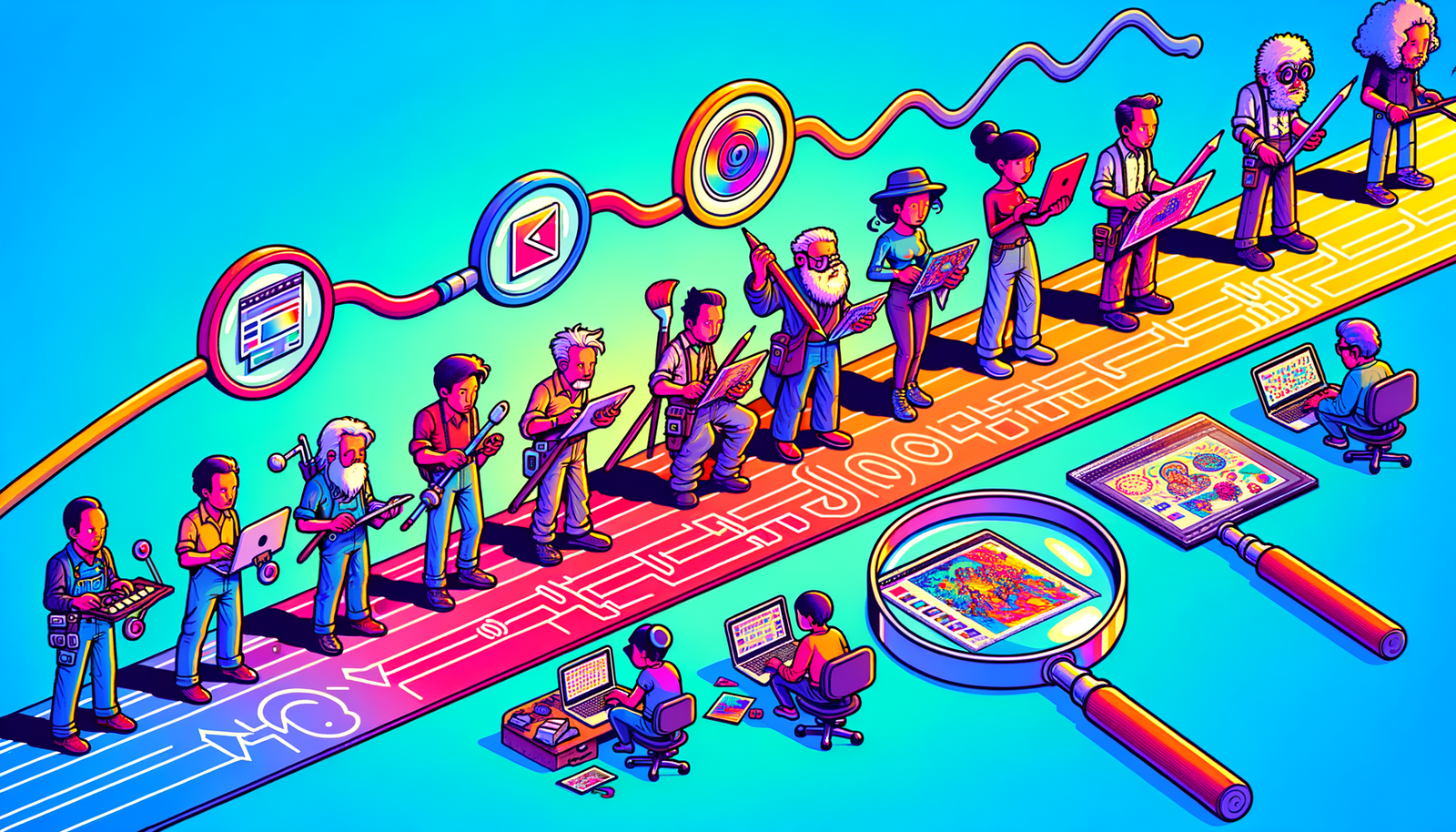Your Cart is Empty
Customer Testimonials
-
"Great customer service. The folks at Novedge were super helpful in navigating a somewhat complicated order including software upgrades and serial numbers in various stages of inactivity. They were friendly and helpful throughout the process.."
Ruben Ruckmark
"Quick & very helpful. We have been using Novedge for years and are very happy with their quick service when we need to make a purchase and excellent support resolving any issues."
Will Woodson
"Scott is the best. He reminds me about subscriptions dates, guides me in the correct direction for updates. He always responds promptly to me. He is literally the reason I continue to work with Novedge and will do so in the future."
Edward Mchugh
"Calvin Lok is “the man”. After my purchase of Sketchup 2021, he called me and provided step-by-step instructions to ease me through difficulties I was having with the setup of my new software."
Mike Borzage
Design Software History: The Evolution and Impact of Real-Time Collaboration in Design Software: A Historical Perspective on Technology and Innovation
March 21, 2025 6 min read


Introduction to Real-Time Collaboration in Design Software
The advent of real-time collaboration features in design software has revolutionized the way designers, engineers, and architects work together in the modern era. No longer confined to isolated workstations, professionals can now seamlessly collaborate across continents, bringing together a myriad of ideas and expertise in a unified digital workspace. This transformation has been pivotal in accelerating project timelines, enhancing creativity, and reducing errors by fostering an environment where team members can interact and contribute simultaneously. In a world where innovation moves at breakneck speed, the ability to collaborate in real time is not just a convenience but a necessity that aligns with the demands of contemporary design processes.
Historically, early design software presented significant limitations in terms of collaboration. In the initial phases of computer-aided design (CAD) during the 1960s and 1970s, software like Sketchpad, developed by Ivan Sutherland, operated on isolated systems with no connectivity to others. Collaboration was a manual process, often involving physical meetings and the exchange of printed materials. As software evolved, designers still faced challenges due to the lack of networked systems and standardized file formats, making it cumbersome to share and integrate work from different sources. This lack of efficient collaborative tools hindered productivity and stifled the potential for innovative, multidisciplinary approaches.
In today's fast-paced, global design environment, the importance of real-time collaboration cannot be overstated. With teams often distributed across various geographic locations, businesses require tools that allow for instantaneous communication and coordination. Real-time collaboration enables simultaneous editing, immediate feedback, and dynamic problem-solving, which are critical in meeting tight project deadlines and adapting to rapid market changes. The integration of these features into design software reflects a broader shift towards connectivity and responsiveness, essential qualities for success in the modern design landscape.
The Evolution of Collaboration in Design Software
The journey towards seamless collaboration in design software began with the early attempts at integrating basic collaborative functions. In the 1980s, software like AutoCAD by Autodesk started gaining prominence, but collaboration was limited to sharing files via physical media or rudimentary network systems. Pioneering companies such as Autodesk and Bentley Systems recognized the need for better collaborative tools and began developing features that allowed multiple users to access and review designs. However, these early efforts were hampered by technological limitations, including slow network speeds and the lack of real-time data synchronization. Designers faced challenges such as version control issues and data corruption, which often led to project delays.
Some of the limitations and challenges faced in the initial stages included:
- Inadequate Network Infrastructure: Early networks were not robust enough to handle large design files, making real-time collaboration impractical.
- Proprietary File Formats: Different software used incompatible file formats, complicating the sharing and integration of designs.
- Lack of Standardization: The absence of standardized collaboration protocols hindered interoperability between systems.
- High Costs: Implementing collaborative solutions required significant investment in hardware and software, limiting adoption.
Significant milestones in the evolution of collaboration came with the introduction of cloud computing and advancements in network technology. The early 2000s saw companies like Autodesk embracing the cloud to enhance their software offerings. The launch of Autodesk 360 provided designers with cloud-based storage and collaborative features, enabling real-time access to projects from any location. Similarly, the emergence of Onshape, a company founded by former SOLIDWORKS executives, introduced a fully cloud-based CAD platform that revolutionized collaborative design. These developments were made possible by advances in high-speed internet and real-time data sharing technologies, which allowed for instantaneous synchronization of design changes and communication among team members.
Advances in network technology, such as the widespread adoption of broadband internet and the development of technologies like WebSocket for real-time communication, played a crucial role. These technologies facilitated the smooth transfer of large amounts of data and supported the responsiveness required for real-time collaboration. The integration of Application Programming Interfaces (APIs) and the use of open standards further enhanced interoperability between different software platforms, making it easier for designers to collaborate regardless of the specific tools they were using.
Key Players and Technologies in Real-Time Collaboration Development
Several influential companies have been instrumental in driving innovation in real-time collaboration features within design software. Autodesk has been a leader in this space, continually evolving its products to include collaborative capabilities. Software like Fusion 360 embodies Autodesk's commitment to integrating design, engineering, and collaboration into a single platform. By leveraging cloud technology, Fusion 360 allows multiple users to work on the same model simultaneously, facilitating a seamless collaborative experience.
Key individuals have played pivotal roles in advancing real-time collaboration. Jon Hirschtick, the founder of SOLIDWORKS and later Onshape, was a visionary in recognizing the potential of cloud-based collaboration. His work with Onshape brought forth one of the first full-cloud 3D CAD systems, eliminating the constraints of desktop-installed software and enabling unprecedented collaborative possibilities. Another notable figure is Andrew Anagnost, CEO of Autodesk, who has been a proponent of cloud technology and subscription models that make advanced collaborative tools more accessible to a broader range of users.
Technological innovations have been the backbone of real-time collaboration in design software. The widespread availability of high-speed internet has made it possible for large design files to be shared and edited in real time without significant latency. Cloud-based platforms have centralized data storage and processing, allowing users to access the latest versions of designs from any device. The integration of Artificial Intelligence (AI)
Impact and Future of Real-Time Collaboration in Design Software
The transformation of design processes through real-time collaboration has been profound. Traditional workflows, which often involved sequential stages and isolated tasks, have evolved into more integrated and agile models. Teams can now work concurrently on different aspects of a project, with changes updated instantly across the board. This shift has led to increased productivity, reduced errors, and faster time-to-market. Industries such as architecture, engineering, and construction (AEC) have particularly benefited, as complex projects involving multiple stakeholders can be more effectively managed. The automotive and aerospace sectors have also seen improvements, with companies like Boeing and Tesla leveraging collaborative tools to streamline design and production processes.
Despite the advancements, challenges and considerations remain in implementing effective real-time collaboration. Data security is a paramount concern, as sharing sensitive design information over networks can expose it to potential breaches. Companies must invest in robust cybersecurity measures to protect intellectual property. There are also issues related to the compatibility of various software tools, as not all platforms integrate smoothly with one another. User adoption can be another hurdle, as teams need to be trained to effectively utilize new collaborative technologies. Resistance to change and the learning curve associated with new software can impede the full realization of collaborative benefits.
Looking forward, the future of real-time collaboration in design software is poised to be shaped by emerging trends and innovations. The integration of AI and machine learning is expected to further enhance collaborative capabilities by automating complex computations and providing intelligent design assistance. Technologies like Virtual Reality (VR) and Augmented Reality (AR) are set to revolutionize the way teams interact with designs, offering immersive experiences that can bridge the gap between the digital and physical worlds. The advent of 5G networks will provide the necessary bandwidth and low latency to support these data-intensive applications, enabling more seamless and responsive collaboration. Additionally, the emphasis on open-source platforms and interoperability will likely grow, promoting greater flexibility and integration across different design tools.
Conclusion
In summary, the evolution of real-time collaboration features in design software has been a transformative force in the industry. From the early days of limited connectivity and isolated workflows, we have moved towards a future where collaboration is integral and instantaneous. This journey has been propelled by technological advancements, visionary companies, and pioneering individuals who recognized the potential of bringing people together through innovative design tools. The impact on industries worldwide has been significant, leading to more efficient processes, enhanced creativity, and the ability to tackle complex projects with greater efficacy.
The continued importance of collaboration cannot be overstated in an increasingly interconnected world. As challenges grow more complex and require multidisciplinary solutions, the ability to harness collective expertise in real time becomes essential. Real-time collaboration not only improves efficiency but also fosters a culture of shared knowledge and innovation. It breaks down barriers between disciplines and geographies, enabling teams to function cohesively regardless of physical location.
Looking ahead, the potential for further developments in design software collaboration is vast. As technologies like AI, VR/AR, and advanced networking mature, they will open up new horizons for how we conceive, develop, and execute design projects. These innovations promise to make collaboration more intuitive, immersive, and effective than ever before. For designers and industries worldwide, embracing these advancements will be key to staying at the forefront of innovation and maintaining a competitive edge in a rapidly evolving landscape.
Also in Design News

Cinema 4D Tip: Lock Framing Early with Cinema 4D Safe Frames and Aspect Overlays
October 30, 2025 2 min read
Read More
ZBrush Tip: Conservative Projection Workflow for Artifact-Free Detail Transfer
October 30, 2025 2 min read
Read More
V-Ray Tip: Bake Static GI into Lightmaps for Real-Time Engines
October 30, 2025 2 min read
Read MoreSubscribe
Sign up to get the latest on sales, new releases and more …


